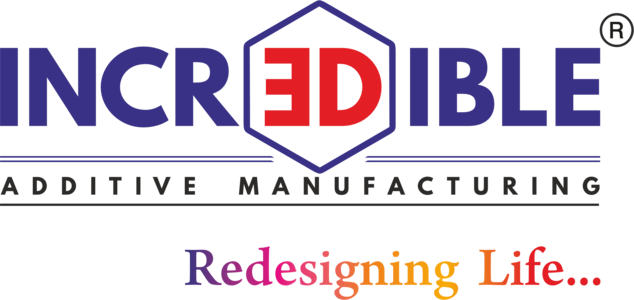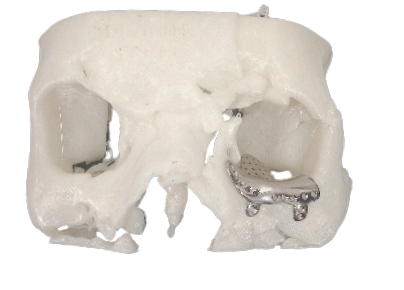
Orbit Floor Implant

The Orbit Floor Implant is crafted to restore the orbital floor, the bony base of the eye socket, and is tailored to match the patient’s specific orbital anatomy. It effectively addresses structural defects, displacements, or damage in the orbital floor. By enhancing the integrity of the orbital base, this implant improves both visual function and facial aesthetics, providing support to surrounding tissues and correcting any displacement.
Material Properties
| Material | Property | Description |
|---|---|---|
| Ti6Al4V-ELI Grade 23 Titanium | Strength | Provides high tensile strength for durable support. |
| Osseointegration | Facilitates strong bonding with the bone for long-term stability. | |
| Corrosion Resistance | Ensures longevity and resistance to environmental factors. | |
| PEEK (Polyether Ether Ketone) | Biocompatibility | Excellent compatibility with human tissue, minimizing the risk of rejection. |
| Radiolucency | Transparent to X-rays for clear imaging of surrounding bone and tissue. | |
| Lightweight | Reduces overall implant weight, enhancing patient comfort. |
Clinical Indications:
| Condition | Description |
|---|---|
| Orbital Fractures | Stabilizes and restores fractures of the orbital floor, often resulting from trauma. |
| Enophthalmos | Restores displacement of the eye into the orbit caused by bony loss or injury. |
| Orbital Deformities | Addresses congenital or acquired deformities of the orbital floor. |
| Sinus Decompression | Assists in sinus surgeries or treatments affecting the orbital area. |
| Volume Restoration | Restores lost volume in the orbital area, ensuring a more natural appearance. |
Patient-Centric Advantages:
| Advantage | Description |
|---|---|
| Enhanced Comfort | Customised fit minimizes pressure points and discomfort, leading to a more natural feel. |
| Improved Visual Function | Restores orbital integrity, enhancing visual function and reducing complications. |
| Aesthetic Improvement | Corrects displacements and restores facial symmetry, enhancing overall appearance. |
Surgeon-Centric Advantages:
| Advantage | Description |
|---|---|
| Precision Fit | Tailored design ensures accurate restoration of the orbital floor, simplifying the surgical process. |
| Reduced Complications | Improved fit and function reduce the risk of post-operative complications. |
| Efficient Procedure | Customization streamlines the surgical process, potentially shortening operative time. |
Sub-Periosteal Implant

The Sub-Periosteal Implant is designed to restore facial contour and support by placing it under the periosteum, the connective tissue surrounding bones. This implant is often used in cases of significant bone loss or facial deformities to enhance structural support and improve facial aesthetics.
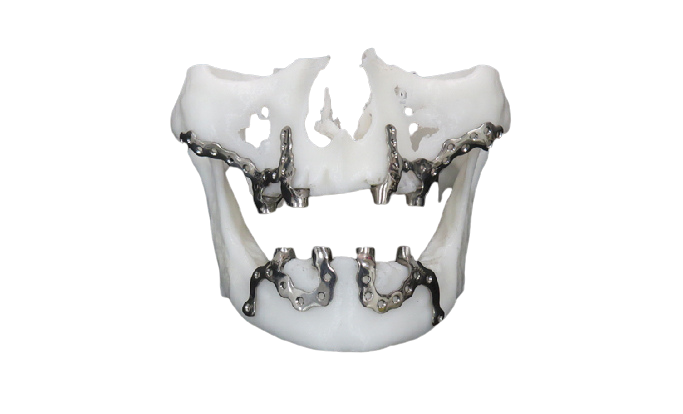
Clinical Indications:
| Indication | Description |
|---|---|
| Facial Bone Loss | Restores facial contour in cases of significant bone loss or resorption. |
| Aesthetic Enhancement | Provides support to enhance facial features and symmetry. |
| Reconstructive Surgery | Assists in reconstructive procedures where conventional bone grafting is not feasible. |
Material: Titanium
| Property | Description |
|---|---|
| Durability | High strength ensures the implant provides reliable support. |
| Osseointegration | Facilitates effective bonding with surrounding bone structures. |
| Corrosion Resistance | Guarantees long-term effectiveness and resilience. |
Patient-Centric Advantages:
| Support for Insufficient Bone: | Ideal for cases with inadequate bone volume, providing stability without extensive bone grafting. |
| Comfortable Fit: | Sits beneath the periosteum, reducing discomfort associated with traditional bone-based implants. |
| Improved Facial Contour: | Enhances facial aesthetics by supporting and reshaping facial structures. |
Material: Titanium – Ti6Al4V-ELI Grade 23 Titanium
| Durability: | High strength ensures the implant provides reliable support. |
| Osseointegration: | Facilitates effective bonding with surrounding bone structures. |
| Corrosion Resistance: | Guarantees long-term effectiveness and resilience. |

Maxilla Implant

The Maxilla Implant is designed to address deficiencies or deformities in the upper jaw (maxilla). Customised fit to the patient’s anatomical needs, this implant supports and restores the maxilla, enhancing dental function, facial appearance, and providing support for prosthetic devices. Its precise design ensures optimal alignment and integration with existing bone structures.
Material: Ti6Al4V-ELI Grade 23 Titanium
| High Strength-to-Weight Ratio: | Provides a robust yet lightweight solution for maxillary reconstruction. |
| Osseointegration: | Promotes strong bonding with natural bone for stable, enduring results. |
| Biocompatibility: | Minimizes the risk of allergic reactions and integrates well with the body’s tissues. |
Clinical Indications
| Maxillary Defects: | Restores defects or deformities in the upper jaw due to trauma, tumour resection, or congenital conditions. |
| Dental Rehabilitation: | Supports dental prosthetics where natural bone is insufficient. |
| Cleft Palate Reconstruction: | Assists in reconstructive procedures for cleft palate patients. |
| Facial Asymmetry: | Addresses asymmetries in the maxillary region to restore a balanced facial appearance. |
Patient-Centric Advantages:
| Improved Dental Function: | Provides robust support for dental prosthetics, enhancing chewing and speaking abilities. |
| Customized Fit: | Aligns perfectly with the patient’s bone structure, ensuring comfort and stability. |
| Enhanced Appearance: | Addresses deficiencies and asymmetries in the upper jaw, improving facial aesthetics. |
Surgeon-Centric Advantages:
| Simplified Prosthetic Placement: | Accurate fit improves the ease of placing dental prosthetics and implants. |
| Minimized Revision Surgeries: | Customized design reduces the likelihood of needing adjustments or additional surgeries. |
| Streamlined Surgical Planning: | Detailed customization supports precise surgical planning and execution. |
Mandible Implant

The Mandible Implant is customized to reconstruct or augment the lower jaw (mandible). Tailored to fit the patient’s unique jawline and anatomical requirements, this implant restores deficiencies or asymmetries, supports chewing function, and improves facial contour. It is essential for supporting dental functions and addressing trauma-related defects.
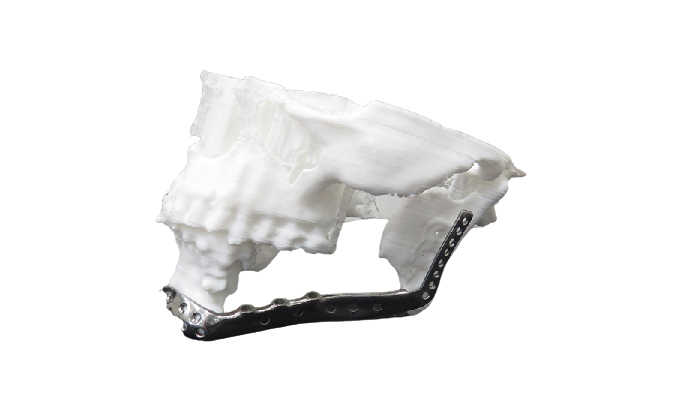
Clinical Indications:
| Mandibular Defects: | Restores and reconstructs defects in the lower jaw from trauma, surgery, or congenital conditions. |
| Jaw Reconstruction: | Supports surgeries following tumour resection or significant bone loss. |
| Dental Prosthetic Support: | Provides a stable base for dental implants or prosthetics. |
| Facial Symmetry Restoration: | Addresses asymmetries to improve jawline appearance and function. |
Material: Ti6Al4V-ELI Grade 23 Titanium
| Durability: | High resistance to wear and corrosion ensures long-lasting performance. |
| Biocompatibility: | Safe for use in the body with minimal risk of adverse reactions. |
| Structural Support: | Provides the necessary strength for effective jaw reconstruction. |
Patient-Centric Advantages:
| Restored Jaw Function: | Enhances chewing and jaw movement, improving oral health and function. |
| Comfortable Fit: | Tailored to fit the patient’s unique anatomy, reducing discomfort. |
| Improved Facial Aesthetics: | Restores deficiencies and asymmetries, enhancing overall facial appearance. |
Surgeon-Centric Advantages:
| Enhanced Stability: | Provides a stable base for dental prosthetics, reducing the risk of post-operative issues. |
| Customizable Design: | Allows for precise adjustments to meet individual anatomical needs, facilitating a more straightforward procedure. |
| Effective Reconstruction: | Addresses a range of mandibular issues, from trauma to congenital defects, with improved outcomes. |
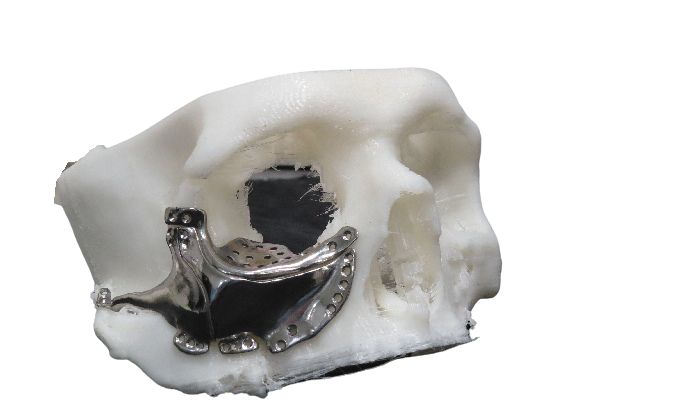
Zygoma Implant

The Zygoma Implant is customized for the zygomatic bone (cheekbone) to address issues such as bone loss or deformities. It is shaped to fit the patient’s facial anatomy, providing support and enhancing cheek contour. This implant is particularly beneficial for patients with significant bone resorption or those undergoing reconstructive surgery.
Material: Ti6Al4V-ELI Grade 23 Titanium
| Strength: | Capable of managing the mechanical demands of the zygomatic region. |
| Osseointegration: | Facilitates effective integration with the zygomatic bone for long-term stability. |
| Corrosion Resistance: | Ensures durability in the facial region. |
Clinical Indications:
| Zygomatic Bone Defects: | Restores and augments the zygomatic bone following trauma, surgery, or congenital deformities. |
| Facial Volume Restoration: | Rebuilds lost volume in the cheek area due to aging or bone loss. |
| Facial Asymmetry: | Addresses asymmetries in the zygomatic region to enhance facial balance. |
| Supporting Prosthetics: | Provides a foundation for dental implants in compromised bone structures. |
Patient-Centric Advantages:
| Restored Facial Volume: | Enhances cheek contour and symmetry, leading to a more youthful and balanced appearance. |
| Improved Support: | Provides a stable foundation for facial structures and prosthetics. |
| Comfortable Fit: | Designed to minimize discomfort and fit naturally with the patient’s anatomy. |
Surgeon-Centric Advantages:
| Enhanced Structural Support: | Provides robust support for facial structures, improving surgical outcomes. |
| Reduced Need for Additional Procedures: | A secure foundation decreases the need for extra interventions or adjustments. |
| Facilitated Surgical Placement: | Customised design simplifies the placement process and enhances surgical accuracy. |
Malar Implant

The Malar Implant is customized for the malar region (high cheekbone area) to enhance volume and contour. It addresses deficiencies or asymmetries, providing a balanced, youthful appearance while offering structural support to improve facial aesthetics.
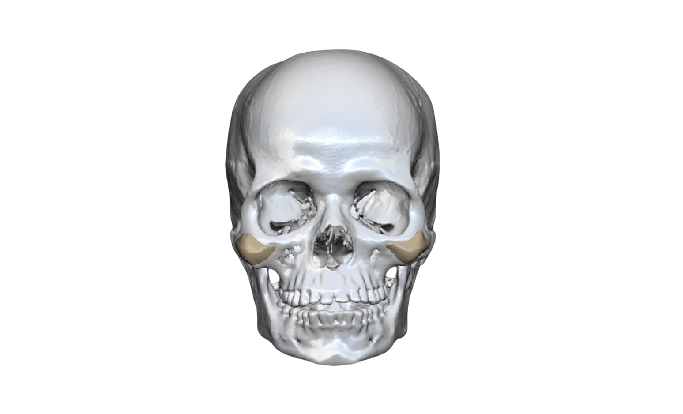
Clinical Indications:
| Malar Deficiencies: | Enhances or restores volume to the cheekbone area due to congenital defects, trauma, or aging. |
| Facial Contour Improvement: | Addresses asymmetries or deficiencies for a balanced and youthful facial contour. |
| Reconstruction Post-Trauma: | Addresses asymmetries in the zygomatic region to enhance facial balance. |
| Supporting Prosthetics: | Assists in reconstructing the cheek area following injuries or surgical interventions. |
Material: PEEK & Titanium
| PEEK (Polyether Ether Ketone) | |
|---|---|
| Biocompatibility: | Highly compatible with human tissue, reducing the likelihood of rejection. |
| Radiolucency: | Allows for detailed imaging and post-operative evaluation. |
| Lightweight: | Reduces overall implant weight for enhanced comfort. |
| Ti6Al4V-ELI Grade 23 Titanium | |
| Strength: | Provides robust support and enhances the structural integrity of the cheekbone area. |
| Osseointegration: | Ensures a strong, stable connection with the bone for lasting results. |
| Corrosion Resistance: | Resists environmental factors, maintaining implant quality over time. |
Patient-Centric Advantages:
| Enhanced Cheek Contour: | Restores volume and balance to the malar region, improving aesthetic outcomes. |
| Reduced Discomfort: | Customised design minimizes irritation and ensures a comfortable fit. |
| Natural Appearance: | Aligns with natural facial features, achieving a harmonious look. |
Surgeon-Centric Advantages:
| Accurate Contouring: | Facilitates precise restoration of the cheekbone area, improving aesthetic results. |
| Efficient Procedure: | Customization supports a smoother and quicker surgical process. |
| Reduced Post-Operative Issues: | Customized fit helps minimize post-surgical complications and adjustments. |

Angle Implant

The Angle Implant is designed for the mandible’s angle (lower posterior jaw area). It restores structural deficiencies or asymmetries, enhancing jawline definition and improving overall facial balance.
Material: PEEK & Titanium
| Material | Advantage | Description |
|---|---|---|
| PEEK (Polyether Ether Ketone) | Biocompatibility | Safe and well-tolerated by the body, minimizing the risk of complications. |
| Radiolucency | Enables clear imaging for precise post-operative assessment. | |
| Stability | Provides consistent performance in various anatomical settings, ensuring reliable support during the healing process. | |
| Ti6Al4V-ELI Grade 23 Titanium | Durability | High strength ensures the implant can withstand mechanical stress in the mandibular angle. |
| Osseointegration | Promotes effective bonding with the bone for a stable outcome. | |
| Corrosion Resistance | Maintains integrity and performance over time. |
Clinical Indications:
| Indication | Description |
|---|---|
| Mandibular Angle Defects | Restores or augments the lower jaw area due to trauma, congenital conditions, or surgical resections. |
| Jawline Definition | Improves the definition and contour of the jawline in patients with weak or asymmetrical angles. |
| Facial Aesthetic Enhancement | Enhances the overall facial profile and balance. |
Patient-Centric Advantages:
| Advantage | Description |
|---|---|
| Improved Jawline Definition | Enhances contour and definition of the jawline for a more attractive profile. |
| Comfortable Fit | Customised design reduces discomfort and ensures a natural feel. |
| Balanced Aesthetics | Restores facial balance by correcting asymmetries and deficiencies. |
Surgeon-Centric Advantages:
| Advantage | Description |
|---|---|
| Simplified Placement | Tailored design ensures a precise fit and alignment, making the surgical process more straightforward. |
| Reduced Post-Operative Complications | Accurate fit decreases the likelihood of complications and the need for revisions. |
Chin Augment Implant

The Chin Augment Implant is designed to enhance or reconstruct the chin area, addressing issues such as a recessed or underdeveloped chin. Customised tailored to fit the patient’s facial anatomy, it improves facial proportions and profile, contributing to a more harmonious appearance.
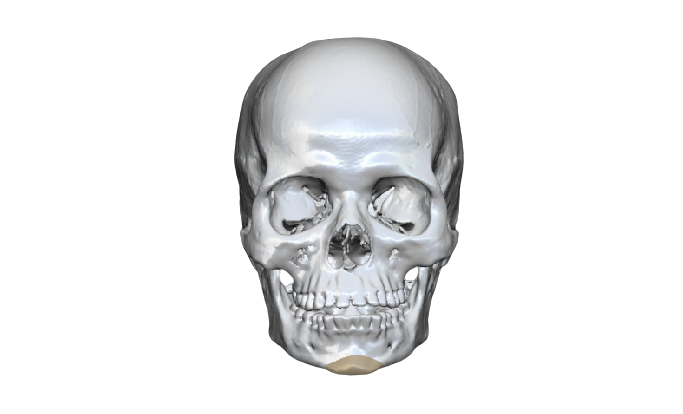
Clinical Indications:
| Indication | Description |
|---|---|
| Chin Recession | Restores a recessed or underdeveloped chin to improve facial proportions. |
| Facial Balance | Enhances the chin area for better harmony with other facial features. |
| Reconstruction | Restores the chin following trauma or surgical interventions. |
Material: PEEK & Titanium
| Material | Feature | Description |
|---|---|---|
| PEEK (Polyether Ether Ketone) |
Biocompatibility | Reduces the risk of adverse reactions and promotes effective healing. |
| Radiolucency | Allows for clear imaging of the chin area for monitoring and adjustments. | |
| Lightweight | Enhances comfort by minimizing the implant’s weight. | |
| Ti6Al4V-ELI Grade 23 Titanium |
Strength | Provides necessary support and stability for chin augmentation. |
| Osseointegration | Ensures a stable connection with the chin bone for long-term success. | |
| Corrosion Resistance | Ensures that the implant remains effective and intact over time. |
Patient-Centric Advantages:
| Advantage | Description |
|---|---|
| Enhanced Facial Proportions | Improves the projection of a recessed chin, enhancing overall facial harmony. |
| Comfortable Fit | Customised design minimizes discomfort and ensures a natural fit. |
| Improved Aesthetics | Enhances chin contour, contributing to a more balanced and attractive profile. |
Surgeon-Centric Advantages:
| Advantage | Description |
|---|---|
| Precise Contouring | Facilitates accurate chin augmentation, improving aesthetic and functional outcomes. |
| Streamlined Procedure | Customized fit supports a more efficient surgical process with fewer adjustments. |
| Reduced Complications | Tailored design helps minimize post-surgical issues and the need for additional interventions. |

Implants for Rhinoplasty

Implants for Rhinoplasty are customized to fit the specific contours of the nose for reshaping and augmenting its structure. These implants address both aesthetic and functional concerns, such as enhancing nasal projection, correcting asymmetries, and supporting the overall appearance and function of the nose.
Material: PEEK & Titanium
| Material | Feature | Description |
|---|---|---|
| PEEK (Polyether Ether Ketone) | Biocompatibility | Highly compatible with nasal tissues, reducing the risk of complications. |
| Radiolucency | Allows for detailed imaging and precise surgical adjustments. | |
| Strength and Flexibility | Balances mechanical strength and flexibility, advantageous for nasal reconstruction. | |
| Ti6Al4V-ELI Grade 23 Titanium | Strength and Flexibility | Provides a balance of mechanical strength and flexibility, beneficial for nasal reconstruction. |
| Biocompatibility | Ensures minimal risk of complications and promotes effective healing. | |
| Corrosion Resistance | Guarantees long-term durability and performance. |
Clinical Indications:
| Indication | Description |
|---|---|
| Nasal Augmentation | Enhances nasal projection or shape for cosmetic improvement or congenital corrections. |
| Nasal Reconstruction | Supports the reconstruction of the nasal structure following trauma, surgery, or tumour resection. |
| Restoring Asymmetries | Addresses irregularities or asymmetries to improve nasal aesthetics. |
| Functional Improvement | Improves nasal function by providing necessary structural support. |
Patient-Centric Advantages:
| Advantage | Description |
|---|---|
| Enhanced Nasal Shape | Achieves desired nasal contours and projection, improving both function and appearance. |
| Comfortable Fit | Custom-designed to match specific nasal structures, reducing discomfort and improving fit. |
| Functional Improvement | Supports nasal function, potentially improving airflow and breathing. |
Surgeon-Centric Advantages:
| Advantage | Description |
|---|---|
| Precise Contouring | Allows for accurate reshaping and augmentation of the nasal structure. |
| Efficient Surgical Planning | Customization aids in effective surgical planning and execution. |
| Reduced Post-Operative Issues | Minimizes the risk of complications and the need for additional adjustments. |
TMJ Implant

The TMJ Implant addresses disorders and structural deficiencies in the temporomandibular joint (TMJ), which connects the lower jaw to the skull. Tailored to the patient’s specific anatomical needs, this implant provides support, restores normal joint function, alleviates pain, improves jaw movement, and enhances overall quality of life.
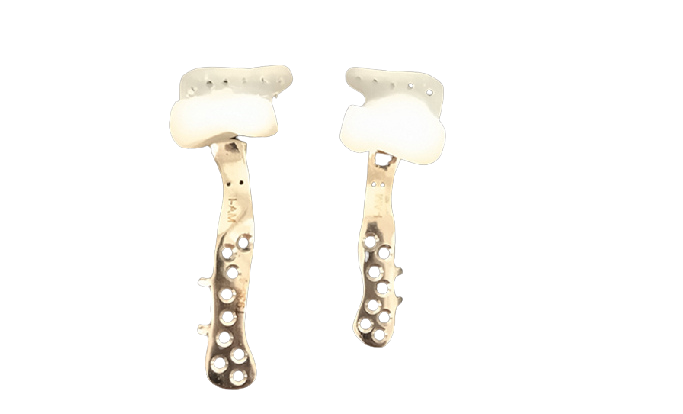
Clinical Indications:
| Indication | Description |
|---|---|
| TMJ Disorders | Manages and treats temporomandibular joint dysfunction (TMD), alleviating pain, clicking, or restricted movement. |
| Joint Degeneration | Replaces or supports the TMJ in cases of degenerative diseases or severe arthritis. |
| Trauma Restoration | Restores or repairs the TMJ following injury or trauma. |
| Congenital Anomalies | Addresses congenital malformations or deficiencies in the TMJ to restore normal function. |
Material: UHMWPE (Ultra-high Molecular Weight Polyethylene) + Titanium
| Component | Key Properties |
|---|---|
| Ti6Al4V-ELI Grade 23 Titanium (Mandibular Component) |
|
| UHMWPE (Fossa Component) |
|
Patient-Centric Advantages:
| Advantage | Description |
|---|---|
| Pain Relief | Alleviates symptoms of TMJ disorders, such as pain and restricted movement, improving quality of life. |
| Enhanced Jaw Function | Restores normal jaw movement and function, aiding in daily activities like eating and speaking. |
| Comfortable Fit | Designed to fit the patient’s specific anatomy, ensuring comfort and effectiveness. |
Surgeon-Centric Advantages:
| Advantage | Description |
|---|---|
| Effective Management | Provides robust support for TMJ disorders, facilitating effective treatment and relief. |
| Customized Fit | Tailored design allows for precise adjustments to meet individual anatomical needs. |
| Streamlined Procedure | Customization supports a more efficient and accurate surgical approach. |
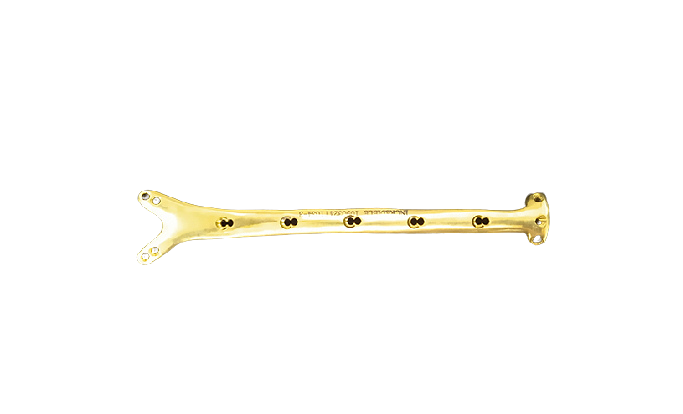
Fibula Graft Solution

The Fibula Graft Solution is a sophisticated approach for reconstructing or augmenting facial structures using a segment of the patient's fibula bone. Ideal for complex reconstructive procedures, this solution involves harvesting the fibula from the patient's leg and using it to rebuild or support facial bones, such as the mandible or maxilla. It includes customised design implants and grafts tailored to the specific anatomical requirements, ensuring a durable and functional outcome for bone reconstruction.
Material:
| Component | Description |
|---|---|
| Bone Graft (Fibula) | A natural bone graft from the patient’s fibula, providing structural strength and integrating seamlessly with existing bone. |
| Customised Implant Materials | Typically made from Titanium or PEEK, these materials are designed to enhance graft integration and functionality. |
Advantages:
| Advantage | Description |
|---|---|
| Structural Strength | The fibula offers robust support, ideal for facial bone reconstruction. |
| Biocompatibility | Being autologous (from the patient), it minimizes rejection risks and promotes natural healing. |
| Customizability | Tailored implants and grafts ensure optimal fit and functionality. |
Components of the Fibula Graft Solution:
| Aspect | Details |
|---|---|
| Description | A detailed 3D model representing the fibula and facial bones to aid in pre-surgical planning and patient education. |
| Features | Accurate depiction of the fibula, mandible, maxilla, and graft placement, along with customised implants. |
| Usage | Helps in strategizing the surgical approach and explaining the procedure to patients. |
| Aspect | Details |
|---|---|
| Description | A tool for accurately harvesting the fibula from the leg. |
| Features | Anatomical landmarks, cutting templates, and a guidance system for precision. |
| Usage | Ensures precise harvesting, minimizing damage and optimizing graft quality. |
| Aspect | Details |
|---|---|
| Description | A guide for planning and executing bone resections in the maxilla or mandible. |
| Features | Customizable templates for defect mapping, cutting guides, and alignment markers. |
| Usage | Facilitates accurate assessment and preparation of the bone defect site for graft placement. |
| Aspect | Details |
|---|---|
| Description | A customised design plate used to stabilize and support the fibula graft. |
| Features | Made from Titanium or biocompatible materials, with customised fit and pre-drilled attachment points. |
| Usage | Provides structural support, maintains graft position, and aids in integration with existing bone. |
- Description: A tool for precisely positioning and aligning the fibula graft during the reconstruction procedure.
- Features: A tool for precisely positioning and aligning the fibula graft during the reconstruction procedure.
- Usage: Ensures accurate graft positioning and simplifies the surgical process.
Implants in Orthognathic Surgery

Patient-Specific Implants (PSI) in orthognathic surgery are customized implants designed to address specific anatomical needs of patients undergoing corrective jaw surgery. These implants are tailored to fit the unique contours of the patient's facial skeleton, aiming to enhance both functional and aesthetic outcomes. By leveraging advanced imaging and 3D modelling, PSI allows for precise reconstruction and alignment of the maxilla (upper jaw) and mandible (lower jaw), addressing misalignments, deformities, and other jaw-related issues.
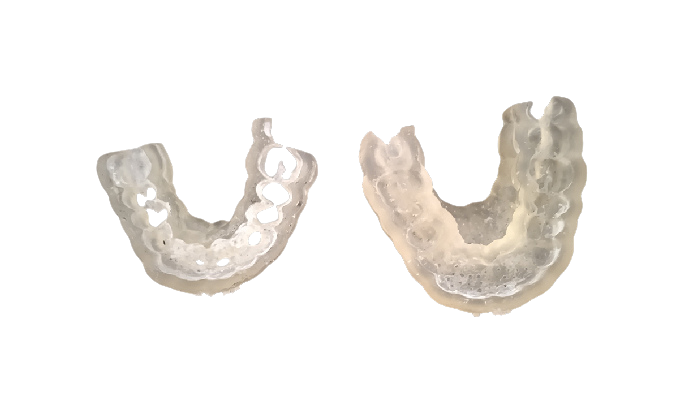
Clinical Indications:
| Condition | Description |
|---|---|
| Jaw Misalignment | Corrects structural misalignments in the maxilla and mandible to improve bite function, occlusion, and overall facial harmony. |
| Facial Asymmetry | Addresses congenital or acquired asymmetries in the jaw, restoring balance and symmetry to the facial profile. |
| Reconstruction Post-Trauma | Provides support and restoration for the jaw following traumatic injuries or surgical resections. |
| Sleep Apnoea | Improves airway patency by repositioning the jaw to alleviate obstructive sleep apnoea symptoms. |
| Functional Disorders | Enhances chewing, speaking, and other oral functions impacted by jaw deformities or malocclusions. |
Materials and Technology:
| Technology | Description |
|---|---|
| 3D Imaging and Modelling | Utilizes high-resolution CT scans and 3D imaging to create accurate models of the patient’s jaw and facial structure. |
| Customised Implants | Fabricated from biocompatible materials such as Titanium or PEEK, these implants are designed to precisely match the patient’s anatomical contours for optimal fit and function. |
Patient-Centric Advantages:
| Advantage | Description |
|---|---|
| Personalized Fit | Customised design implants ensure a perfect fit with the patient’s unique anatomy, leading to better surgical outcomes and reduced discomfort. |
| Enhanced Aesthetics | PSI improves the alignment and contour of the jaw, leading to a more balanced and harmonious facial appearance. |
| Faster Recovery | By achieving precise alignment and reducing the need for additional adjustments, PSI can lead to quicker recovery times and less postoperative pain. |
Surgeon-Centric Advantages:
| Advantage | Description |
|---|---|
| Increased Accuracy | Patient-specific implants allow for precise surgical planning and execution, minimizing errors and enhancing the overall success of the procedure. |
| Improved Surgical Planning | Advanced 3D models enable detailed preoperative planning, which helps in anticipating and addressing potential challenges during surgery. |
| Reduced Complications | Customised implants reduce the likelihood of complications and the need for revisions, as they are specifically tailored to the patient’s anatomical requirements. |
Components of PSI Orthognathic Surgery:
Surgical Workflow:
| Stage | Details |
|---|---|
| 1. Preoperative Planning |
|
| 2. Customised Implants |
|
| 3. Surgical Procedure |
|
| 4. Postoperative Care |
|
